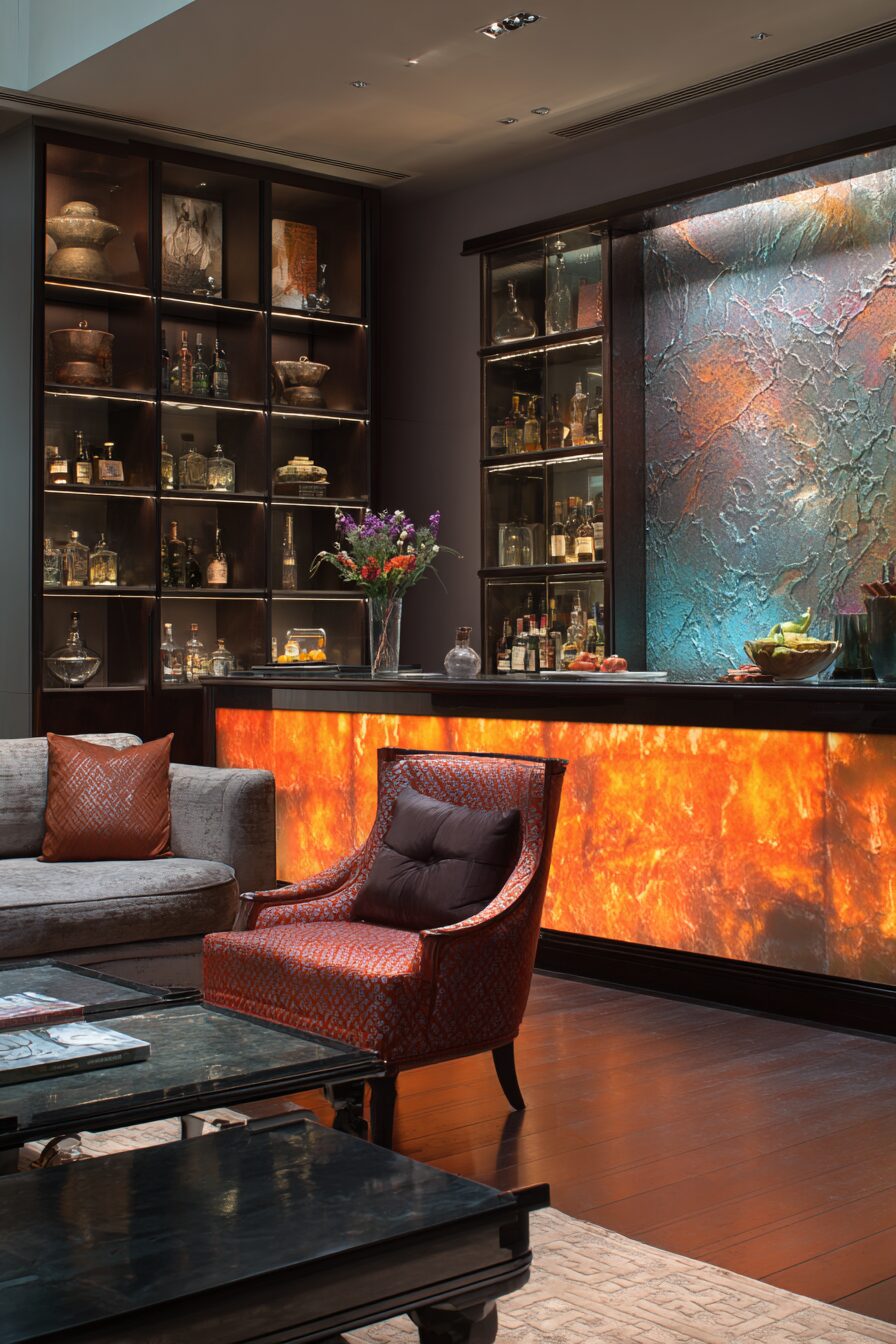Ever walked into someone’s home and been immediately drawn to that sleek built-in bar that seems to elevate the entire living space?
Those jaw-dropping home bars aren’t just for the ultra-wealthy anymore.
With clever design and strategic planning, your living room can feature a stunning built-in bar that becomes the centerpiece of your entertainment space.
The Secret Bookshelf Bar: Literature Meets Libations
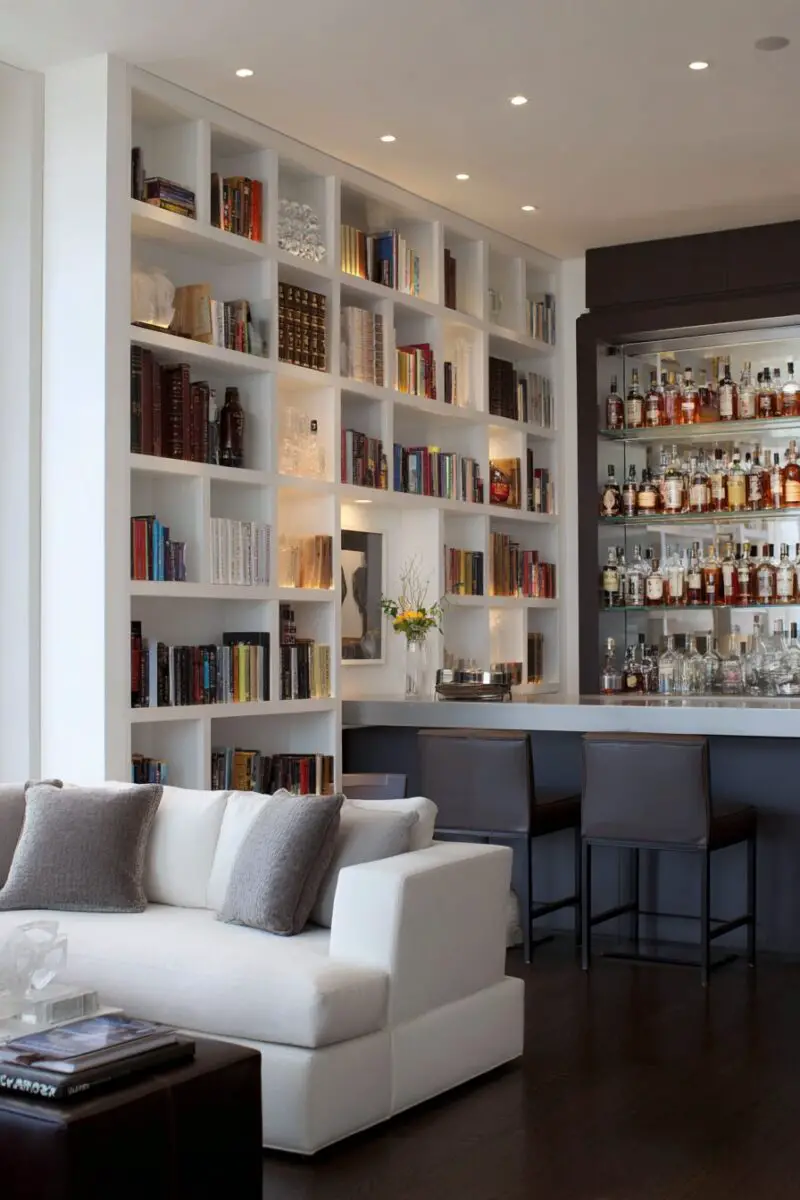
Nothing captures attention quite like a secret door, and a bookshelf that opens to reveal a fully stocked bar might just be the coolest thing you’ll ever add to your home.
This design plays on the classic speakeasy concept but brings it into your modern living room with style.
The front-facing wall appears to be a normal bookshelf, perhaps showcasing your collection of novels or decorative items.
With a gentle push or the press of a hidden button, the bookshelf swings open to expose your private bar area.
The interior can be designed with mirrored backsplashes to create the illusion of more space.
LED lighting installed along shelving edges brings a dramatic glow to your glassware and bottles.
The beauty of this design lies in its versatility – when closed, it’s a sophisticated bookshelf; when open, it’s party central.
You can customize the exterior to match any aesthetic from traditional wood paneling to sleek modern designs.
Some homeowners even install small wheels on the bottom of the bookshelf to ensure smooth opening and closing without damaging your flooring.
For added drama, consider installing automatic opening mechanisms that respond to voice commands or a remote control.
Your guests will never forget the moment when your ordinary-looking bookshelf transforms into an elegant bar.
To maximize space efficiency, install glass racks on the ceiling of the hidden area to store stemware.
The inside walls can feature wallpaper or paint in rich, dramatic colors that contrast with your living room for added impact.
Don’t forget to include a small workspace for mixing drinks, complete with a tiny sink if plumbing allows.
Madison’s Current Obsessions
Whiskey Lounge Decor Ideas So Stylish, You’ll Want To Show Off Your Space!The Window Nook Transformation: Cocktails With a View
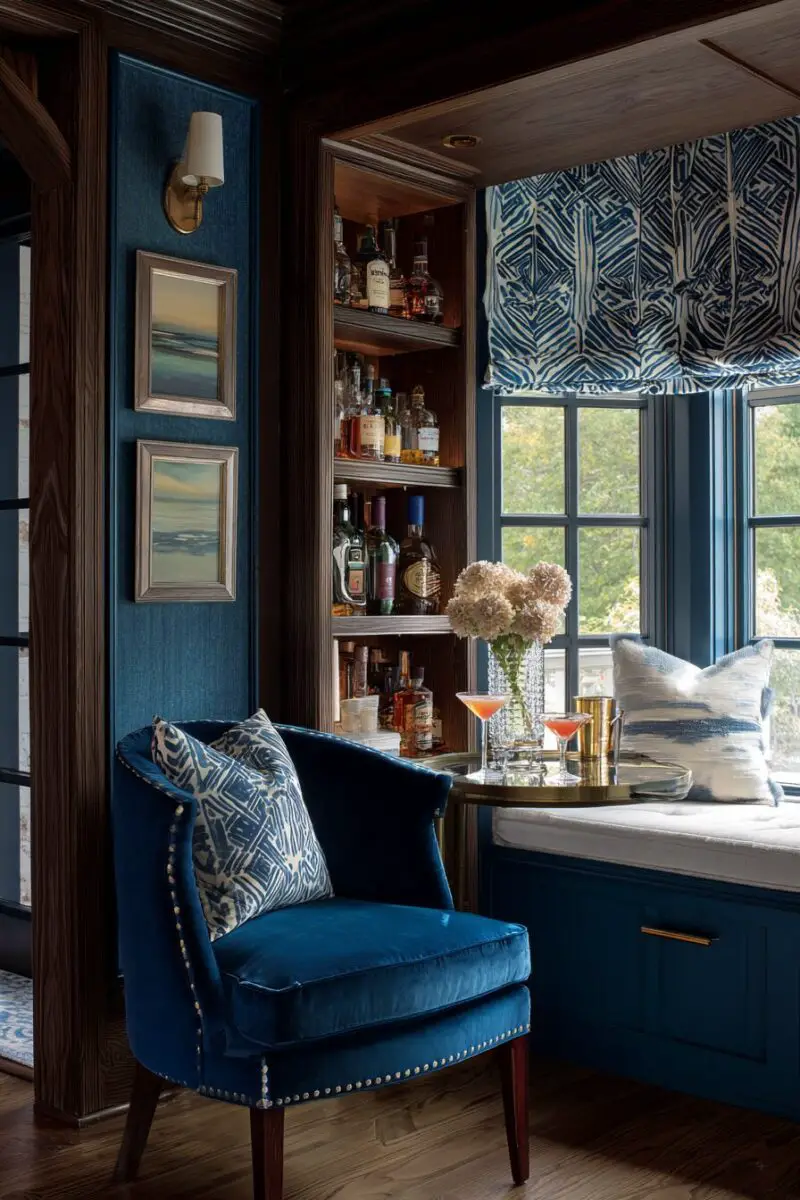
That awkward bay window or window nook that you’ve never quite figured out what to do with?
It’s practically begging to become a stunning built-in bar that capitalizes on natural light.
Window nooks offer a unique opportunity to create a bar space that feels both connected to your living room and set apart in its own special zone.
The natural light during daytime hours will make your liquor bottles and glassware sparkle, creating an ever-changing display as the sun moves across the sky.
Installing a countertop across the window sill creates an instant bar surface, while cabinets below provide essential storage.
You can add floating shelves on either side of the windows to display your finest spirits without blocking any of that precious natural light.
Pendant lights hanging from the ceiling over the bar area add task lighting for evening cocktail preparation while creating a defined zone within your living room.
A cushioned bench along the window can provide seating that doubles as storage for less frequently used items.
Temperature control becomes important with this design, so consider using UV-filtering window film to protect your spirits from sun damage.
The view outside becomes part of your bar’s appeal, creating a backdrop that changes with the seasons.
For privacy without sacrificing light, consider installing bottom-up blinds that cover only the lower portion of the windows.
This design works particularly well in urban settings where the city lights create a dramatic nighttime backdrop for evening entertaining.
This style of bar makes excellent use of otherwise challenging architectural features in your living room.
Adding plants that thrive in bright light can bring an extra dimension of life to your window bar area.
Design Your Dream Room in Minutes!
🏡 Start Creating FREE →Madison’s Current Obsessions
These Home Lounge Room Bar Ideas Are A Must-See!The Floating Wall Display: Minimalist Magic
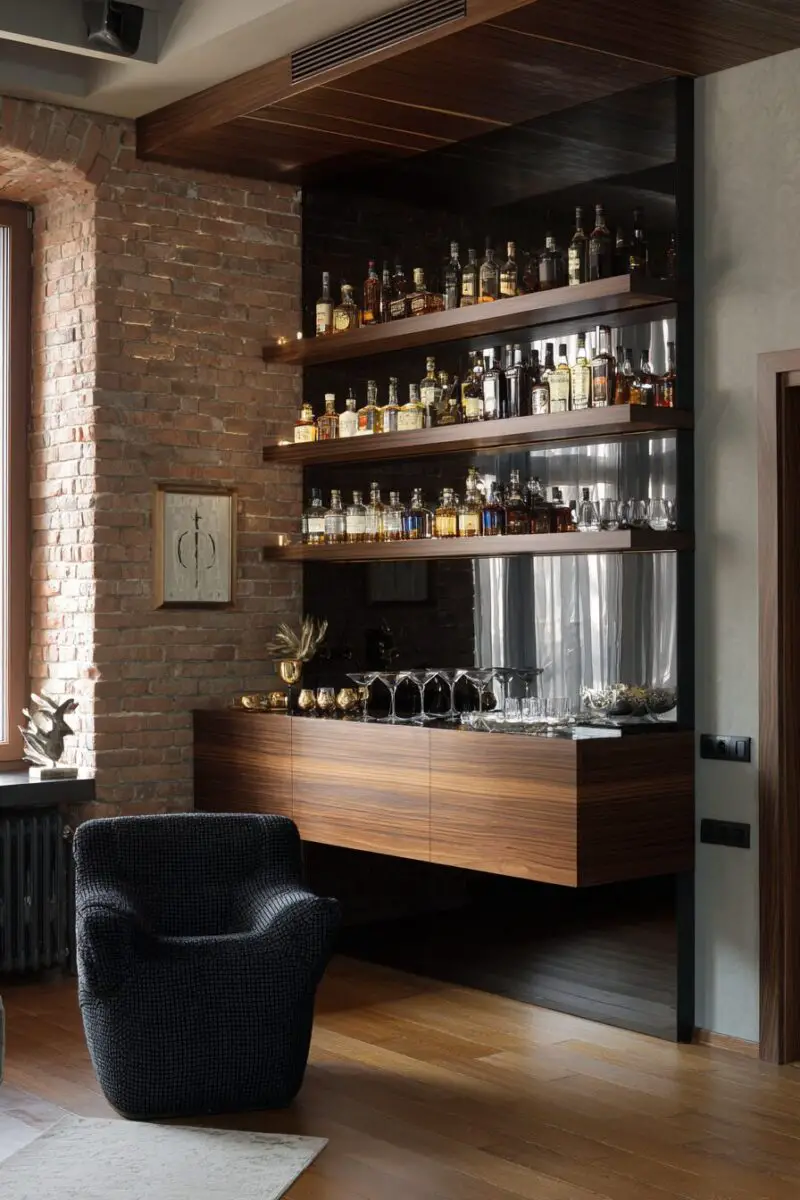
For the modern minimalist who appreciates clean lines and uncluttered spaces, the floating wall display bar offers spectacular visual impact with a small footprint.
This design mounts directly to your wall, seemingly floating in space without bulky supports or cabinets.
The beauty of this design lies in its apparent simplicity that masks clever engineering and thoughtful design.
A slender floating shelf extends from the wall at counter height, providing just enough space for mixing drinks.
Above this working surface, illuminated glass shelves showcase your collection of spirits in what appears to be mid-air.
LED lighting is absolutely crucial to this design, with strips installed behind and beneath each shelf to create a dramatic glowing effect.
The transparent or translucent shelving allows light to play through bottles, creating prismatic effects on your walls.
Without lower cabinets, this design maintains an open, airy feel that works perfectly in smaller living rooms where visual space is important.
Storage is cleverly integrated with narrow cabinets recessed into the wall itself, maintaining the floating illusion.
Custom bottle holders can be incorporated that grip the bottlenecks, making it appear as if your collection is suspended in midair.
The minimalist approach means selecting fewer, more premium bottles that become part of your room’s visual aesthetic.
Color-coordinating your liquor bottles can create a stunning ombré effect across your display.
This design works particularly well against dark-colored walls where the lighting effects create maximum drama.
For added functionality without compromising the floating aesthetic, consider a pull-out cutting board that slides back into the wall when not in use.
The wall-mounted design keeps your valuable floor space free, making your living room feel larger and more open.
Madison’s Current Obsessions
Turn Your Closet Into a Coffee BarThe Repurposed Fireplace Bar: Old Meets New
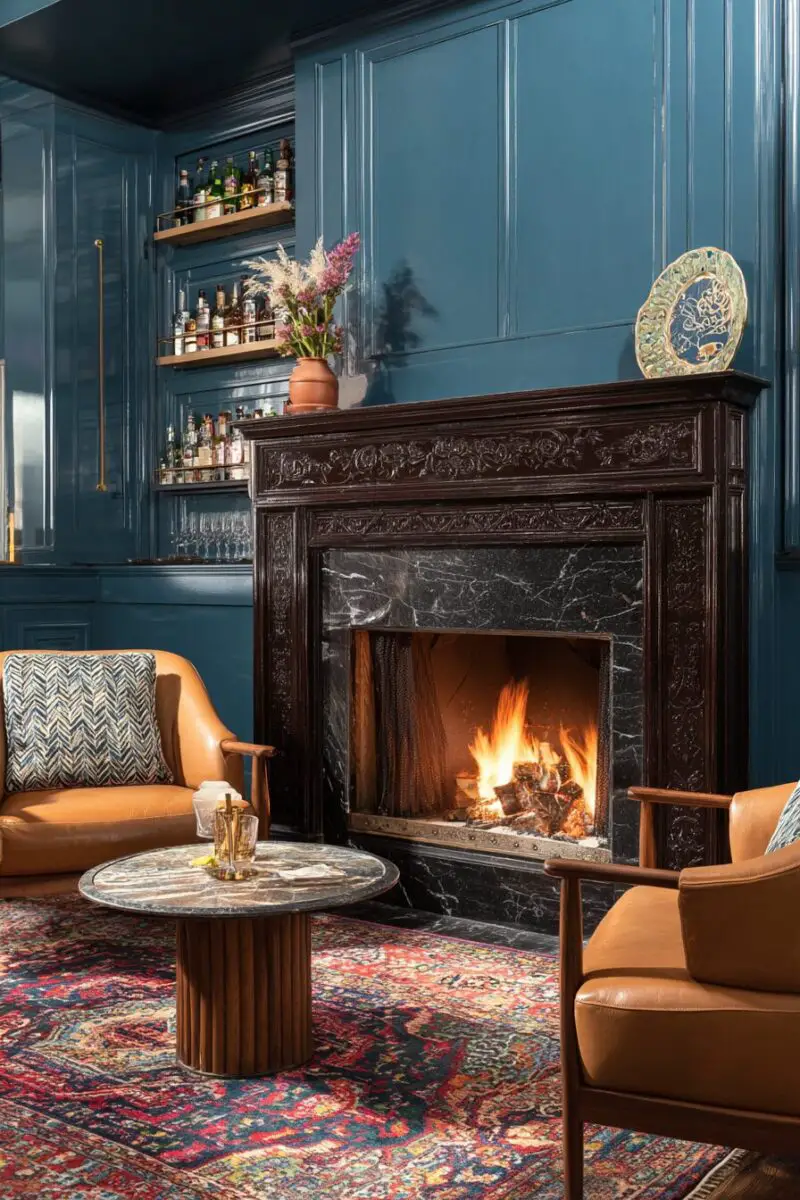
If your living room has a non-working fireplace that’s been sitting unused, you’re looking at prime real estate for a truly unique built-in bar.
This conversation-starting design preserves architectural character while adding modern functionality to your space.
The existing fireplace alcove provides a ready-made nook that’s typically at the perfect height for a bar installation.
The mantel serves as a natural display shelf for your most impressive bottles or cocktail books.
Inside the firebox itself, you can install shelving for glassware and spirits, utilizing what was once empty space.
Mirrored backing inside the fireplace opening creates depth and reflects light, making your display even more dramatic.
Adding subtle lighting inside the former firebox creates a warm glow that echoes the fireplace’s original purpose.
If your fireplace has a raised hearth, this becomes a perfect footrest for bar seating arranged in front.
For a truly show-stopping element, consider installing a small wine refrigerator or ice maker inside a deeper firebox.
The vertical space of a tall fireplace opening allows for impressive tiered shelving to maximize storage.
This design works particularly well in older homes where preserving character details adds value while updating functionality.
You can install a fold-down work surface that disappears when not in use if space is at a premium.
This repurposing project honors your home’s history while creating a thoroughly modern entertaining space.
Madison’s Current Obsessions
Top Ways To Create A Cozy Jazz BarThe Kitchen Extension Bar: Seamless Entertaining

For open-concept homes where the kitchen flows into the living area, extending your kitchen cabinetry to create a living room bar creates cohesion between spaces.
This design creates a natural transition zone that bridges the gap between food preparation and relaxation areas.
By using the same cabinetry style, countertop material, and hardware as your kitchen, you create a custom built-in that looks like it was always part of the original design.
The extension can be configured as a peninsula or island depending on your floor plan and traffic flow needs.
Including seating on the living room side creates a natural gathering spot that doesn’t pull guests completely away from the kitchen action.
Under-cabinet lighting continues from the kitchen to your bar area, creating visual continuity.
This design allows you to tap into existing plumbing if your kitchen is adjacent, making it easier to include a small bar sink.
Storage can be customized to transition from kitchen needs to bar essentials as the cabinetry extends into the living space.
Glass-front cabinets or open shelving in the bar section creates visual interest while maintaining the design connection.
This approach often costs less than a completely separate bar installation since it extends existing features.
The kitchen extension bar works particularly well for frequent entertainers who want to remain part of the conversation while preparing food and drinks.
For added definition, consider a slight change in countertop material or a decorative inlay that marks the transition from kitchen to bar.
This design maximizes functionality in smaller homes where separate dedicated spaces aren’t practical.
Including outlets and charging stations makes this area multifunctional for work-from-home days as well as entertaining.
Madison’s Current Obsessions
Transform Your Home With Unique Bar Nook IdeasThe Under-Stair Speakeasy: Making Dead Space Delightful
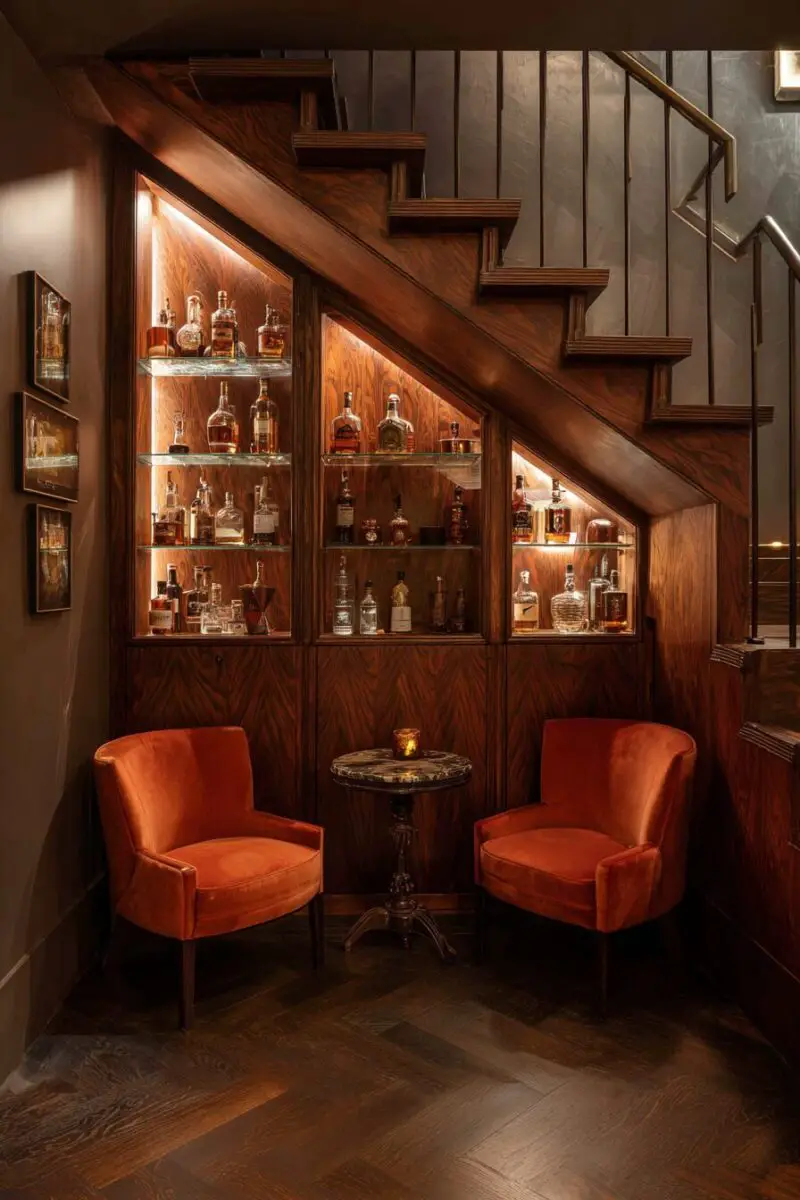
That awkward space under your staircase might be the perfect spot for a compact but fully-functional built-in bar that maximizes every inch of your home.
This clever use of often-wasted space transforms a storage dumping ground into a sophisticated entertaining zone.
The triangular space naturally creates a cozy nook that feels intimate and special.
The varying ceiling height actually works to your advantage, with taller bottles stored at the higher end and glassware at the lower end.
Installing LED strip lighting under each stair tread above creates dramatic illumination for your bar display.
The confined space lends itself perfectly to the speakeasy aesthetic, creating a naturally secluded feeling.
A mirrored backsplash makes the area feel larger while reflecting your bottle display for added visual impact.
Custom-fitted shelving that follows the slope of the stairs ensures no space is wasted.
A narrow counter provides just enough space for mixing drinks without encroaching on valuable floor area.
For homes with open-concept layouts, this under-stair bar becomes a natural divider between living zones.
The unique shape offers opportunities for custom solutions like triangular wine racks or graduated shelving.
This location often works well for plumbing connections if you want to include a small sink.
The under-stair location typically places your bar at the heart of your home’s circulation, making it convenient for entertaining throughout the house.
Madison’s Current Obsessions
Must-See Basement Bar Ideas You’ll LoveThe Convertible Entertainment Center: Dual-Purpose Design
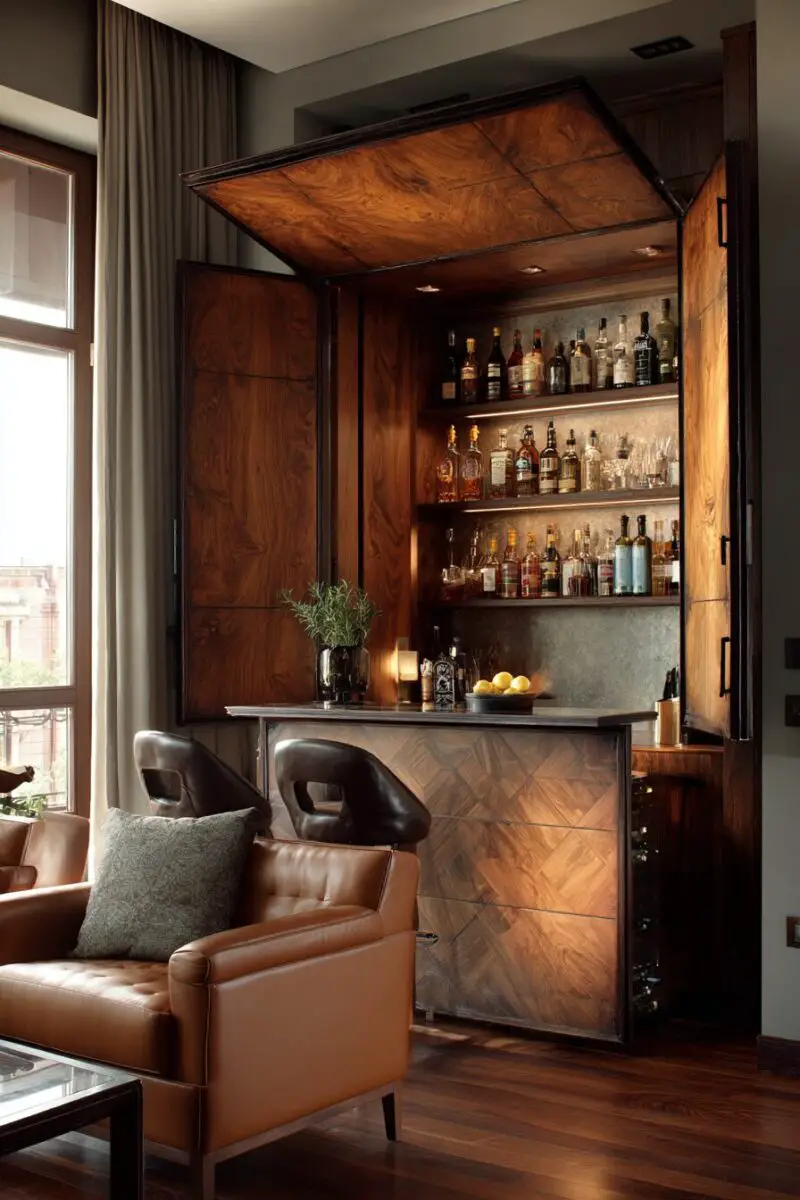
The modern living room often features a large entertainment center, but with thoughtful design, this same space can transform into an impressive bar when movie night ends.
This dual-purpose approach maximizes your square footage while creating flexibility in how you use your living space.
The key to this design is clever compartmentalization and movable components that shift function as needed.
Central TV sections remain static while flanking cabinets convert from media storage to bar functionality.
Drop-down panels transform into serving surfaces with the touch of a button or pull of a lever.
Hidden compartments behind media storage reveal glassware and bar tools when swiveled or opened.
LED lighting schemes can shift from movie-watching mode to entertaining mode with programmable settings.
Automated systems can be incorporated that transform your space with a single command to your smart home system.
This approach works particularly well for smaller homes where dedicated single-purpose spaces aren’t practical.
When designing this system, focus on smooth transitions between functions to enhance the wow factor.
Including sound system controls within your bar setup allows for perfect playlist management during parties.
Remote-controlled or motorized components add serious drama to the transformation process.
The entertainment center bar often becomes the focal point for different types of gathering in the same space throughout a single evening.
For maximum flexibility, include a combination of open shelving and closed storage to display decorative items during family time and bar essentials during parties.
The Vintage Cabinet Transformation: Upcycled Elegance
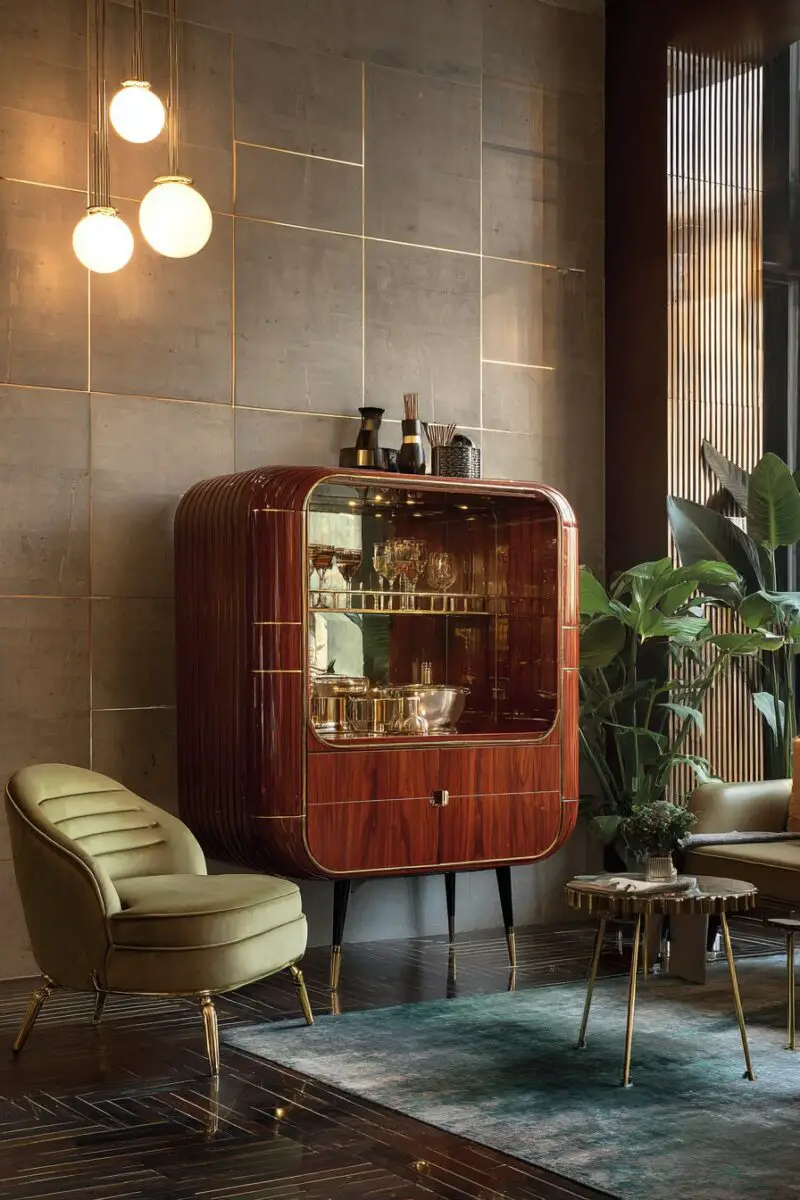
Breathing new life into antique furniture creates a bar with character, history, and uniqueness impossible to replicate with new construction.
This approach appeals to sustainability-minded homeowners who appreciate the quality of older craftsmanship with modern functionality.
Antique armoires, sideboards, china cabinets, and secretary desks all make excellent candidates for conversion to stunning built-in bars.
The transformation process typically involves removing some interior components while preserving the distinctive exterior details.
Original hardware becomes a character feature that would cost a fortune to replicate in new construction.
Mirrored backing can be added to showcase glassware while reflecting light in ways that enhance antique woodwork.
Custom inserts can be built to hold specific bottle types while working within the vintage framework.
The patina of aged wood creates a warmth and character that new materials simply can’t match.
For functionality, you can add a modern countertop material inside that contrasts beautifully with the vintage exterior.
This approach often costs less than building from scratch while creating a completely one-of-a-kind result.
Vintage glass doors become a showcase for your collection with historical character built in.
This style works particularly well in traditional or transitional living rooms where connecting to design history feels appropriate.
The beauty of this approach is that no two vintage cabinet bars will ever be exactly alike, ensuring your design remains unique.
The Indoor-Outdoor Connection: Window Wall Bar
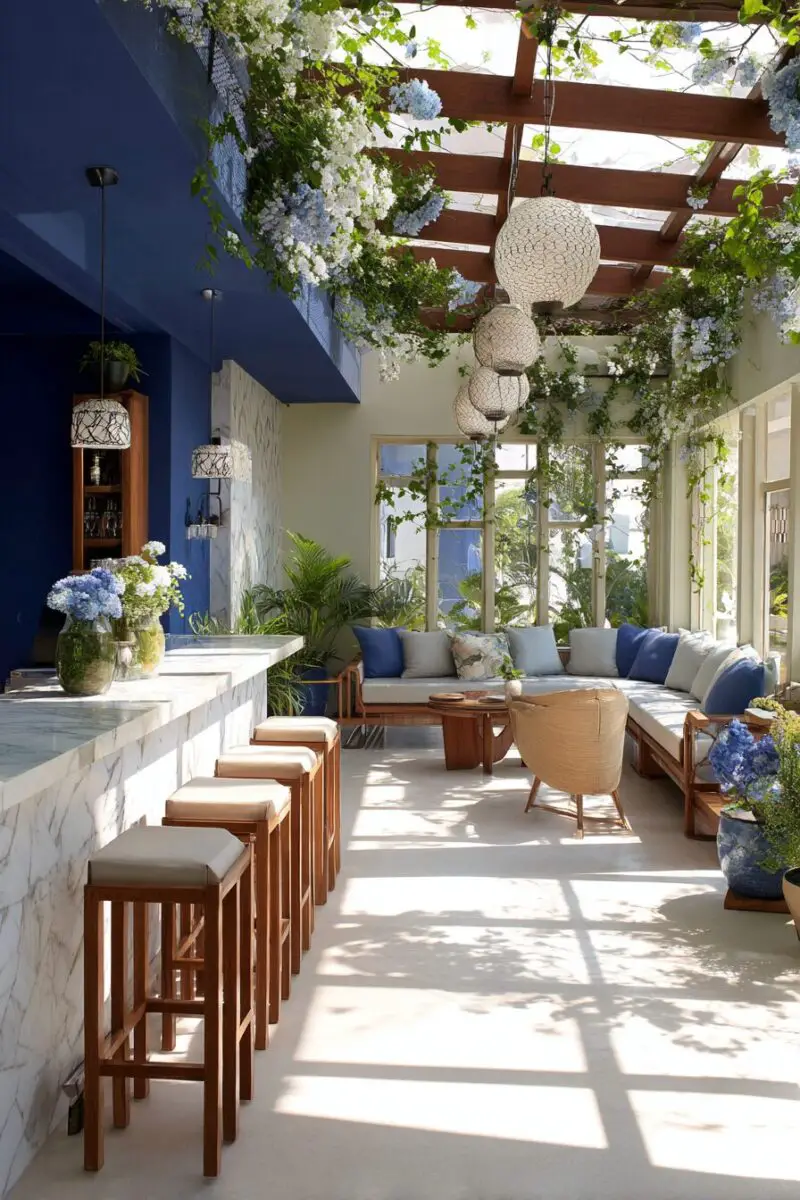
For homes blessed with beautiful views or outdoor living spaces, a bar built into a window wall creates a seamless transition between indoor and outdoor entertaining.
This design capitalizes on your home’s natural assets while creating a uniquely functional space.
The bar counter typically extends along the interior wall beneath windows, with a pass-through feature that allows serving to outdoor spaces.
Large sliding or folding doors can open completely to transform the bar into an indoor-outdoor serving station during good weather.
This design often incorporates indoor and outdoor seating that mirrors each other across the window threshold.
Strategic lighting ensures the space functions beautifully from daylight through evening hours.
Temperature-controlled wine storage can be incorporated into the lower cabinetry to keep bottles at perfect serving temperature regardless of outdoor conditions.
The window wall bar becomes a natural gathering spot that connects guests in different areas of your property.
Consider including small gardens of fresh herbs near the bar for craft cocktail ingredients literally at your fingertips.
This design works particularly well in temperate climates where indoor-outdoor living is possible much of the year.
For colder regions, excellent insulation and perhaps even heating elements in the countertop make this space usable year-round.
The views become part of your bar’s appeal, changing with seasons and times of day.
Strategic placement of mirrors can bring outdoor views to guests seated with their backs to the windows.
This connection to the outdoors brings natural elements into your bar design in a way that feels organic and refreshing.
The Artistic Statement Bar: When Design Meets Function
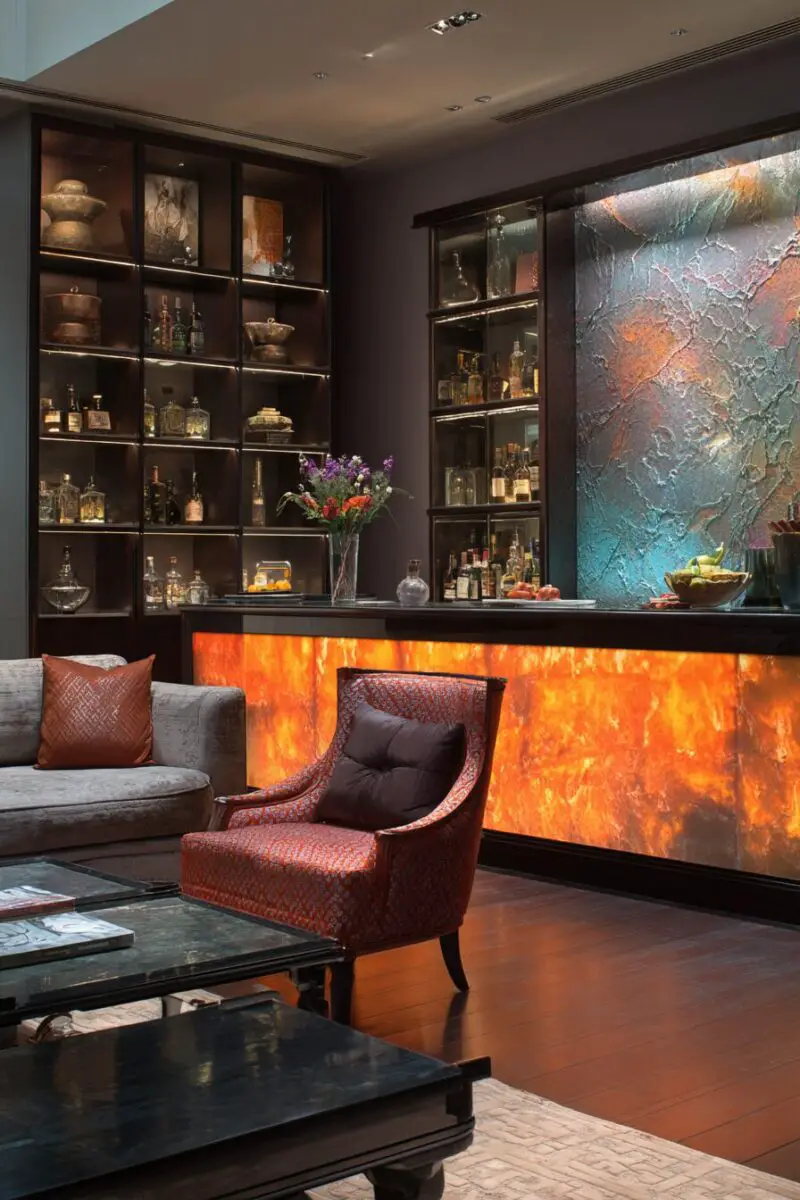
For the truly unique home, a bar designed as an artistic statement piece creates a one-of-a-kind focal point that defines your living space.
This approach treats your bar not just as functional furniture but as a sculptural element that transforms your room.
Unusual materials like reclaimed industrial components, artistic glass, or sculptural metal become the foundation of the design.
Custom lighting is designed specifically to highlight the artistic elements while providing functional illumination.
The artistic bar often incorporates unexpected shapes that break away from traditional rectangular cabinetry.
Bottle display becomes part of the artistic composition, with specific places designed for statement pieces in your collection.
This design might incorporate moving parts that transform the bar’s appearance when opened or closed.
Artistic bars often play with height, depth, and dimension in ways that traditional cabinetry doesn’t explore.
Consider incorporating digital elements like programmable LED displays that can change the bar’s appearance for different occasions.
The functional elements are carefully integrated to maintain the artistic integrity while ensuring practicality.
This approach often becomes a significant investment but creates a truly unique feature that defines your home.
Color theory and composition principles guide the design rather than just traditional cabinetry approaches.
The artistic statement bar becomes not just where you serve drinks but a reflection of your personal style and appreciation for design.
When designed thoughtfully, this becomes the piece that guests remember and discuss long after visiting your home.
Today’s designs integrate seamlessly with your living space while making bold statements about your personal style.
Remember that the best built-in bar is one that reflects how you actually entertain while enhancing your living room’s overall design.
Cheers to creating a space that perfectly blends form and function in your home!

